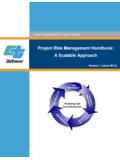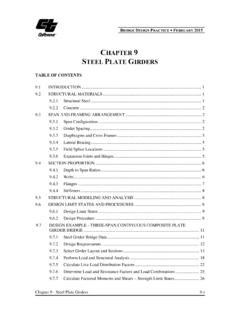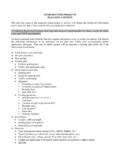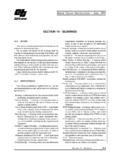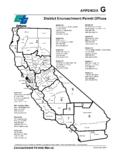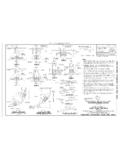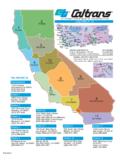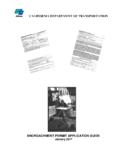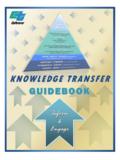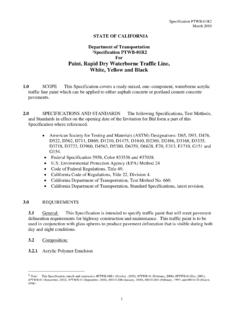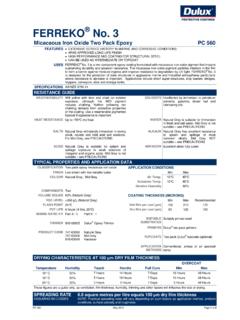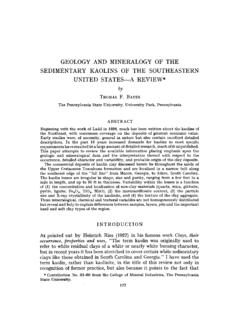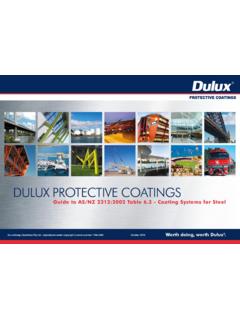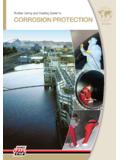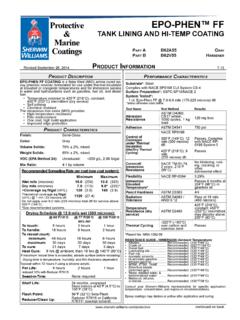Transcription of SECTION 4 - FOUNDATIONS
1 BRIDGE DESIGN SPECIFICATIONS NOVEMBER 2003. SECTION 4 - FOUNDATIONS . Part A. measured by in situ and/or laboratory tests. The bearing General Requirements and Materials capacity may also be determined using load tests. GENERAL Settlement FOUNDATIONS shall be designed to support all live and The settlement of FOUNDATIONS may be determined dead loads, and earth and water pressure loadings in using procedures described in Articles , , or for accordance with the general principles specified in this service load design and Articles , , or for SECTION . The design shall be made either with reference to strength design, or other generally acepted methodolo . service loads and allowable stresses as provided in SER- gies. Such methods are based on soil and rock parameters VICE LOAD DESIGN or, alternatively, with reference measured directly or inferred from the results of in situ to load factors, and factored strength as provided in and/or laboratory tests. STRENGTH DESIGN. Overall Stability FOUNDATION TYPE AND.
2 CAPACITY The overall stability of slopes in the vicinity of foun . dations shall be considered as part of the design of Selection of Foundation Type FOUNDATIONS . Selection of foundation type shall be based on an Soil, Rock, and Other Problem assessment of the magnitude and direction of loading, Conditions depth to suitable bearing materials, evidence of previous flooding, potential for liquefaction, undermining or scour, Geologic and environmental conditions can influence swelling potential, frost depth and ease and cost of the performance of FOUNDATIONS and may require special construction. consideration during design. To the extent possible, the presence and influence of such conditions shall be evalu . Foundation Capacity ated as part of the subsurface exploration program. A. representative, but not exclusive, listing of problem con . FOUNDATIONS shall be designed to provide adequate ditions requiring special consideration is presented in structural capacity, adequate foundation bearing capac Table for general guidance.
3 Ity with acceptable settlements, and acceptable overall stability of slopes adjacent to the FOUNDATIONS . The toler . able level of structural deformation is controlled by the SUBSURFACE EXPLORATION AND. type and span of the superstructure. TESTING PROGRAMS. Bearing Capacity The elements of the subsurface exploration and test . ing programs shall be the responsibility of the designer The bearing capacity of FOUNDATIONS may be estimated based on the specifice requirements of the project and his using procedures described in Articles , , or for or her experience with local geologic conditions. service load design and Articles , , or for strength design, or other generally accepted theories. Such theories are based on soil and rock parameters SECTION 4 FOUNDATIONS 4-1. BRIDGE DESIGN SPECIFICATIONS NOVEMBER 2003. TABLE Problem Conditions Requiring Special Consideration Problem Type Description Comments Organic soil; highly plastic clay Low strength and high compressibility Sensitive clay Potentially large strength loss upon large straining Micaceous soil Potentially high compressibility (often saprolitic).
4 Soil Expansive clay/silt; expansive slag Potentially large expansion upon wetting Liquefiable soil Complete strength loss and high deformations due to earthquake loading Collapsible soil Potentially large deformations upon wetting (Caliche; Loess). Pyritic soil Potentially large expansion upon oxidation Laminated rock Low strength when loaded parallel to bedding Expansive shale Potentially large expansion upon wetting; degrades readily upon exposure to air/water Pyritic shale Expands upon exposure to air/water Rock Soluble rock Soluble in flowing and standing water (Limestone, Limerock, Gypsum). Cretaceous shale Indicator of potentially corrosive ground water Weak claystone (Red Beds) Low strength and readily degradable upon exposure to air/water Gneissic and Schistose Rock Highly distorted with irregular weathering profiles and steep discontinuities Subsidence Typical in areas of underground mining or high ground water extraction Sinkholes/solutioning Karst topography; typical of areas underlain by carbonate rock strata Condition Negative skin friction/ Additional compressive/uplift load on deep FOUNDATIONS due to expansion loading settlement/uplift of soil Corrosive environments Acid mine drainage.
5 Degradation of certain soil/rock types Permafrost/frost Typical in northern climates Capillary water Rise of water level in silts and fine sands leading to strength loss General Requirements Rock strata Depth to rock As a minimum, the subsurface exploration and testing Identification and classification programs shall define the following, where applicable: Quality ( , soundness, hardness, jointing and presence of joint filling, resistance to weather . Soil strata ing, if exposed, and solutioning). Depth, thickness, and variability Compressive strength ( , uniaxial compres . Identification and classification sion, point load index). Relevant engineering properties ( , shear Expansion potential strength, compressibility, stiffness, permeabil Ground water elevation ity, expansion or collaspe potential, and frost Ground surface elevation susceptibility) Local conditions requiring special consideration 4-2 SECTION 4 FOUNDATIONS . BRIDGE DESIGN SPECIFICATIONS NOVEMBER 2003. Exploration logs shall include soil and rock strata rock core, or a length of rock core equal to three times the +.
6 Descriptions, penetration resistance for soils ( , SPT or pile or shaft diameter below anticipated tip elevation, +. qc), and sample recovery and RQD for rock strata. The whichever is greater, shall be obtained to insure the +. drilling equipment and method, use of drilling mud, type exploration has not been terminated on a boulder. For +. of SPT hammer ( safety, donut, hydraulic) or cone shaft group bearing on rock the exploration shall pen +. penetrometer ( , mechanical or electrical), and any etrate sufficient depth into competent rock to determine +. unusual subsurface conditions such as artesian pressures, the physical characteristics of rock within the zone of +. boulders or other obstructions, or voids shall also be foundation influence for design. +. noted on the exploration logs. Minimum Coverage Minimum Depth Unless the subsurface conditions of the site are known +. Where substructure units will be supported on spread to be uniform, a minimum of one soil boring shall be make +.
7 Footings, the minimum depth of the subsurface explora for each substructure unit. For substructure units over +. tion shall extend below the anticipated bearing level a 100' in width, a minimum of two borings shall be required. +. minimum of two footing widths for isolated, individual footings where L< 2B, and four footing widths for foot Laboratory Testing ings where L > 5B. For intermediate footing lengths, the minimum depth of exploration may be estimated by Laboratory testing shall be performed as necessary to linear interpolation as a function of L between depths of determine engineering properties including unit weight, 2B and 5B below the bearing level. Greater depths may shear strength, compressive strength and compressibil . be required where warranted by local conditions. ity. In the absence of laboratory testing, engineering Where substructure units will be supported on deep properties may be estimated based on published test FOUNDATIONS , the depth of the subsurface exploration shall results or local experience.
8 Extend a minimum of 20 feet below the anticipated pile or + shaft tip elevation. Where pile or shaft groups will be Scour + used, the subsurface exploration shall penetrate suffi . + cient depth into firm stable material to insure that signifi The probable depth of scour shall be determined by + cant settlement will not develop from compression of the subsurface exploration and hydraulic studies. Refer to + deeper soils due to loads imposed by the structure. For Article and FHWA (1988) for general guidance + piles or shafts bearing on rock, a minimum of 10 feet of regarding hydraulic studies and design. SECTION 4 FOUNDATIONS 4-3. BRIDGE DESIGN SPECIFICATIONS NOVEMBER 2003. Part B. bearing pressure as nearly uniform as practical. For foot . Service Load Design Method ings supported on piles or drilled shafts, the spacing Allowable Stress Design between piles and drilled shafts shall be designed to ensure nearly equal loads on deep foundation elements as SPREAD FOOTINGS may be practical.
9 When footings support more than one column, pier, or General wall, distribution of soil pressure shall be consistent with properties of the foundation materials and the structure, Applicability and with the principles of geotechnical engineering. Provisions of this Article shall apply for design of Notations isolated footings, and to combined footings and mats (footings supporting more than one column, pier, or The following notations shall apply for the design of wall). spread footings on soil and rock: A = Contact area of footing (ft2). Footings Supporting Non- A' = Effective footing area for computation of Rectangular Columns or Piers bearing capacity of a footing subjected to eccentric load (ft2); (See Article ). Footings supporting circular or regular polygon-shaped bc,b ,bq = Base inclination factors (dim); (See Ar . concrete columns or piers may be designed assuming that ticle ). the columns or piers act as square members with the same B = Width of footing (ft); (Minimum plan di.)
10 Area for location of critical sections for moment, shear, mension of footing unless otherwise noted). and development of reinforcement. B' = Effective width for load eccentric in direc . tion of short side, L unchanged (ft). Footings in Fill c = Soil cohesion (ksf). c' = Effective stress soil cohesion (ksf). + Footings located in fill are subject to the same bearing c* = Reduced effective stress soil cohesion for + capacity and settlement considerations as footings in punching shear (ksf); (See Article ). + natural soil in accordance with Articles through ca = Adhesion between footing and foundation + The behavior of both the fill and underlying soil or rock (ksf); (See Article ). + natural soil shall be considered. cv = Coefficient of consolidation (ft2/yr); (See Article ). Footings in Sloped Portions of c1 = Shear strength of upper cohesive soil layer Embankments below footing (ksf); (See Article ). The earth pressure against the back of footings and c2 = Shear strength of lower cohesive soil layer columns within the sloped portion of an embankment below footing (ksf); (See Article shall be equal to the at-rest earth pressure in accordance ).
